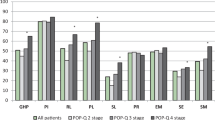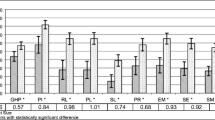Abstract
Introduction and hypothesis
The aim of this study was to validate the Thai version of the Prolapse Quality of Life (P-QOL) questionnaire.
Methods
The P-QOL questionnaire was translated into Thai. Test–retest reliability and internal consistency were tested. All patients who visit the gynecologic outpatient clinic of King Chulalongkorn Memorial Hospital between March 2008 and September 2009 completed the P-QOL questionnaires.
Results
One hundred fifteen patients with symptomatic pelvic organ prolapse and 60 asymptomatic patients were included. There was a significant correlation between P-QOL domain scores and vaginal examination findings (POP-Q stage). A higher POP-Q stage and a higher impact on quality of life were detected in symptomatic patients. The total scores from all domains were significantly higher in symptomatic patients.
Conclusion
The Thai version of the P-QOL questionnaire is a valid, reliable, and simple instrument to assess the symptoms’ severity and the quality of life in Thai-speaking patients with pelvic organ prolapse.
Similar content being viewed by others
References
Luber KM, Boero S, Choe JY (2001) The demographics of pelvic floor disorders: current observations and future projections. Am J Obstet Gynecol 184:1496–1501
Olsen AL, Smith VJ, Bergstrom JO, Colling JC, Clark AL (1997) Epidemiology of surgically managed pelvic organ prolapse and urinary incontinence. Obstet Gynecol 89:501–506
Swift SE (2000) The distribution of pelvic organ support in a population of female subjects seen for routine gynecologic health care. Am J Obstet Gynecol 183:277–285
Chuenchompoonut V, Bunyavejchevin S, Wisawasukmongchol W, Taechakraichana N (2005) Prevalence of genital prolapse in Thai menopausal women (using new standardization classification). J Med Assos Thail 88:1–4
Digesu GA, Santamato S, Khullar V, Santillo V, Digesu A, Cormio G, Loverro G, Selvaggi L (2003) Validation of an Italian version of the prolapse quality of life questionnaire. Eur J Obstet Gynecol Reprod Biol 106:184–192
Digesu GA, Khullar V, Cardozo L, Robinson D, Salvatore S (2005) P-QOL: a validated questionnaire to assess the symptoms and quality of life of women with urogenital prolapse. Int Urogynecol J Pelvic Floor Dysfunct 16:176–181
Cam C, Sakalli M, Ay P, Aran T, Cam M, Karateke A (2007) Validation of the prolapse quality of life questionnaire (P-QOL) in a Turkish population. Eur J Obstet Gynecol Reprod Biol 135:132–135
Lenz F, Stammer H, Brocker K, Rak M, Scherg H, Sohn C (2009) Validation of a German version of the P-QOL Questionnaire. Int Urogynecol J Pelvic Floor Dysfunct 20:641–649
de Oliveira MS, Tamanini JT, de Aguiar CG (2009) Validation of the Prolapse Quality-of-Life Questionnaire (P-QoL) in Portuguese version in Brazilian women. Int Urogynecol J Pelvic Floor Dysfunct 20:1191–1202
Svihrova V, Digesu GA, Svihra J, Hudeckova H, Kliment J, Swift S (2010) Validation of the Slovakian version of the P-QOL questionnaire. Int Urogynecol J Pelvic Floor Dysfunct 21:53–61
Bump RC, Mattiasson A, Bo K, Brubaker LP, DeLancey JO, Klarskov P, Shull BL, Smith AR (1996) The standardization of terminology of female pelvic organ prolapse and pelvic floor dysfunction. Am J Obstet Gynecol 175:10–17
Swift SE, Tate SB, Nicholas J (2003) Correlation of symptoms with degree of pelvic organ support in a general population of women: what is pelvic organ prolapse? Am J Obstet Gynecol 189:372–377
Espuna Pons M (2009) Sexual health in women with pelvic floor disorders: measuring the sexual activity and function with questionnaires—a summary. Int Urogynecol J Pelvic Floor Dysfunct 20(Suppl 1):S65–S71
Fukumoto Y, Uesaka Y, Yamamoto K, Ito S, Yamanaka M, Takeyama M, Noma M (2008) Assessment of quality of life in women with pelvic organ prolapse: conditional translation and trial of P-QOL for use in Japan. Nippon Hinyokika Gakkai Zasshi 99:531–542
Fayyad AM, Redhead E, Awan N, Kyrgiou M, Prashar S, Hill SR (2008) Symptomatic and quality of life outcomes after site-specific fascial reattachment for pelvic organ prolapse repair. Int Urogynecol J Pelvic Floor Dysfunct 19:191–197
Sivaslioglu AA, Unlubilgin E, Dolen I (2008) A randomized comparison of polypropylene mesh surgery with site-specific surgery in the treatment of cystocoele. Int Urogynecol J Pelvic Floor Dysfunct 19:467–471
Funding
None.
Conflicts of interest
None.
Author information
Authors and Affiliations
Corresponding author
Appendix
Appendix




Rights and permissions
About this article
Cite this article
Manchana, T., Bunyavejchevin, S. Validation of the Prolapse Quality of Life (P-QOL) questionnaire in Thai version. Int Urogynecol J 21, 985–993 (2010). https://doi.org/10.1007/s00192-010-1107-3
Received:
Accepted:
Published:
Issue Date:
DOI: https://doi.org/10.1007/s00192-010-1107-3




